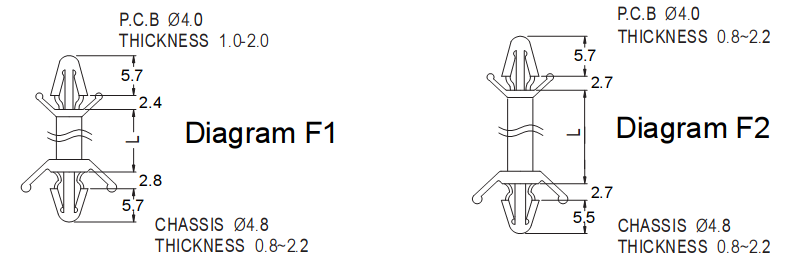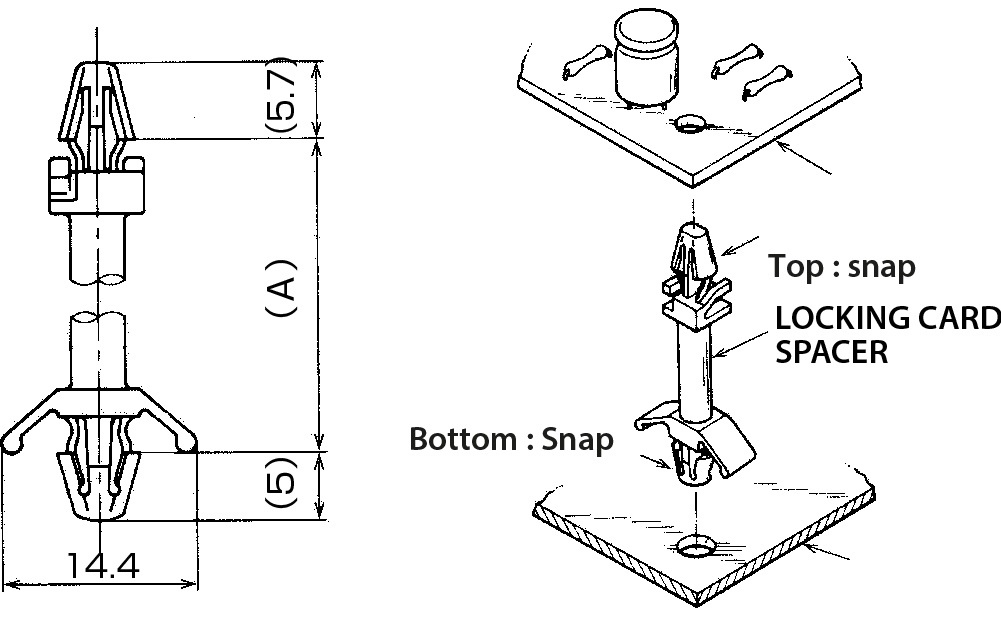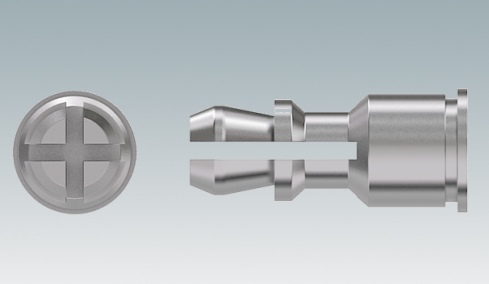PCBS7系列上下不对称电路板间隔柱
共10种不同的间隔高度可选。建议上层板安装孔径Φ4.0,下层板安装孔径Φ4.8-5.0
信诺华工业PCBS7系列PCB间隔柱设计为上下非对称结构,适合应用于PCB板孔径和底部孔径不一致的场合。
可以起到隔离固定处于多层平面
上的PCB板或者壳体的作用,同时也可以为PCB板上的敏感电子元件预留出一定的空间使其不受其他机械结构件的接触甚至挤压而造成损坏。
轻量化,绝缘。节约空间。
安装简单,无需任何工具。效率高。节约人工成本。
同时这种卡锁式结构电路板支撑柱由于安装时无需多余的螺丝螺母等其他零散紧固件,方便物料管理,也节省了物料成本。

| 物料编号 | L | 上层板孔径 | 上层板厚度 | 底板孔径 | 底板厚度 | 图示 | 材料 | 颜色 |
| PCBS701 | 4.8 | 4.0 | 1.0-2.0 | 4.8 | 0.8-2.2 | F 1 | 尼龙66 | 本色 |
| PCBS702 | 6.4 | 4.0 | 1.0-2.0 | 4.8 | 0.8-2.2 | F 1 | 尼龙66 | 本色 |
| PCBS703 | 9.7 | 4.0 | 1.0-2.0 | 4.8 | 0.8-2.2 | F 1 | 尼龙66 | 本色 |
| PCBS704 | 12.7 | 4.0 | 1.0-2.0 | 4.8 | 0.8-2.2 | F 1 | 尼龙66 | 本色 |
| PCBS705 | 15.9 | 4.0 | 1.0-2.0 | 4.8 | 0.8-2.2 | F 1 | 尼龙66 | 本色 |
| PCBS706 | 19.1 | 4.0 | 0.8-2.2 | 4.8 | 0.8-2.2 | F 2 | 尼龙66 | 本色 |
| PCBS707 | 22.2 | 4.0 | 0.8-2.2 | 4.8 | 0.8-2.2 | F 2 | 尼龙66 | 本色 |
| PCBS708 | 25.4 | 4.0 | 0.8-2.2 | 4.8 | 0.8-2.2 | F 2 | 尼龙66 | 本色 |
| PCBS709 | 28.5 | 4.0 | 0.8-2.2 | 4.8 | 0.8-2.2 | F 2 | 尼龙66 | 本色 |
| PCBS710 | 35.0 | 4.0 | 0.8-2.2 | 4.8 | 0.8-2.2 | F 2 | 尼龙66 | 本色 |
![]() PCBS7xx 系列电路板间隔柱图纸下载 PDF 112KB
PCBS7xx 系列电路板间隔柱图纸下载 PDF 112KB

以上PCBS7系列是我们畅销的非对称卡扣锁定结构PCB间隔柱,如下的KGLS系列产品功能和使用上和上述产品一样。这是一种国内设计人员不太选用但是在日本市场比较受欢迎的电路板间隔柱。
LOCKING CARD SPACER / KGLS-S and BKGLS-S
| 物料编号 | A | B | 上层板孔径 | 上层板厚度 | 底板孔径 | 底板厚度 | 材料 | 颜色 |
| KGLS-3SCN | 9.8 | 5.9 | 4.0 | 1.0-2.0 | 4.8 | 0.8-2.2 | 尼龙66 | 本色 |
| KGLS-4SCN | 11.4 | 7.5 | 4.0 | 1.0-2.0 | 4.8 | 0.8-2.2 | 尼龙66 | 本色 |
| KGLS-6SCN | 14.4 | 10.5 | 4.0 | 1.0-2.0 | 4.8 | 0.8-2.2 | 尼龙66 | 本色 |
| KGLS-7SCN | 16.6 | 12.7 | 4.0 | 1.0-2.0 | 4.8 | 0.8-2.2 | 尼龙66 | 本色 |
| KGLS-8SCN | 17.7 | 13.8 | 4.0 | 1.0-2.0 | 4.8 | 0.8-2.2 | 尼龙66 | 本色 |
| KGLS-10SCN | 20.9 | 17 | 4.0 | 1.0-2.0 | 4.8 | 0.8-2.2 | 尼龙66 | 本色 |
| KGLS-12SCN | 24.1 | 20.2 | 4.0 | 1.0-2.0 | 4.8 | 0.8-2.2 | 尼龙66 | 本色 |
| KGLS-14SCN | 27.2 | 23.3 | 4.0 | 1.0-2.0 | 4.8 | 0.8-2.2 | 尼龙66 | 本色 |
| KGLS-16SCN | 30.4 | 26.5 | 4.0 | 1.0-2.0 | 4.8 | 0.8-2.2 | 尼龙66 | 本色 |
| KGLS-18SCN | 33.6 | 29.7 | 4.0 | 1.0-2.0 | 4.8 | 0.8-2.2 | 尼龙66 | 本色 |
| KGLS-22SCN | 39.9 | 36 | 4.0 | 1.0-2.0 | 4.8 | 0.8-2.2 | 尼龙66 | 本色 |
| BKGLS-3SCN | 9.8 | 5 | 4.0 | 1.0-2.0 | 4.8 | 0.8-3.0 | 尼龙66 | 本色 |
| BKGLS-4SCN | 11.4 | 6.6 | 4.0 | 1.0-2.0 | 4.8 | 0.8-3.0 | 尼龙66 | 本色 |
| BKGLS-6SCN | 14.4 | 9.6 | 4.0 | 1.0-2.0 | 4.8 | 0.8-3.0 | 尼龙66 | 本色 |
| BKGLS-7SCN | 16.6 | 11.8 | 4.0 | 1.0-2.0 | 4.8 | 0.8-3.0 | 尼龙66 | 本色 |
| BKGLS-8SCN | 17.7 | 12.9 | 4.0 | 1.0-2.0 | 4.8 | 0.8-3.0 | 尼龙66 | 本色 |
| BKGLS-12SCN | 24.1 | 19.3 | 4.0 | 1.0-2.0 | 4.8 | 0.8-3.0 | 尼龙66 | 本色 |
| BKGLS-14SCN | 27.2 | 22.4 | 4.0 | 1.0-2.0 | 4.8 | 0.8-3.0 | 尼龙66 | 本色 |
| BKGLS-16SCN | 30.4 | 25.6 | 4.0 | 1.0-2.0 | 4.8 | 0.8-3.0 | 尼龙66 | 本色 |
| BKGLS-18SCN | 33.6 | 28.8 | 4.0 | 1.0-2.0 | 4.8 | 0.8-3.0 | 尼龙66 | 本色 |
| BKGLS-22SCN | 39.9 | 35.1 | 4.0 | 1.0-2.0 | 4.8 | 0.8-3.0 | 尼龙66 | 本色 |
KGLS系列和BKGLS系列PCB间隔支撑柱的区别是底部装配板板厚范围的差异(具体请查阅表格)。

更多飞机头形卡扣自锁固定式PCB间隔柱产品,欢迎您点击这里了解。
Snap Lock PCB Spacer/Standoffs
Easy to install dual locking PCB supports that require no special tools;
Simply press the head, which expands the rivet base - locking it into position. Supplied in standard packs of 1000pcs
Standard material: Nylon6/6,UL94V2, nature colour.
UL94V0 spacers/standoffs is available by special order, add suffix"V0" at the end of these part numbers.
PCB standoffs are used to separate a PCB from other components. These standoffs are available in female-female or male-female configurations. This favors a wide range of PCB applications. The female-female has an internal threat on each end. The female-male has an internal thread on one end and an external threaded screw on the other. This enables the components to be well secured together.
What are the features and benefits of circuit board standoffs?
- Come in hexagonal, square, or cylindrical designs that allow tightening with a wrench.
- Threaded joint or snap tensional lock available;
- for metal standoff and sapcers,brass nickel plating/steel zinc plating/stainless steel making them resistant to oxidation and corrosion;
- Metal PCB spacers and standoffs are suitable for mechanical strength and resistance to high-temperature environments.
- Metal standoffs keep the electricity conductivity, maintaining a circuit
- Versatile and easy to fit
- Secure PCBs into place
How do PCB standoffs fit together?
For circuit board standoffs to get a perfect fit, they must be of the correct size. With the correct size, the standoff is chosen and inserted into the PCB. It is easy to align them with pre-drilled holes in the PCB. A metric screw is then fastened into the thread of the standoff to lock it firmly in place.
The screws can also be released and retightened as required. A female standoff can be screwed into a male standoff provided the threads are of the same size.
What is the purpose of PCB standoffs?
- Standoffs’ use spread across various electronic applications for creating spacing between individual PCBs.
- They act as spacers to separate PCB boards from other components.
- They are ideal for use in applications where you need mechanical strength
- The mild steel construction is useful in high-temperature environments
- Applications range from consumer electronics, office machinery, datacoms, and telecommunications equipment.
- They fasten the board securely to the device, ensuring no movement happens when the device is under use.
- PCB standoffs prevent parts from coming into contact with each other. This helps to prevent any shorts from happening to keep the devices safer.
Available PCB standoff styles
Standoffs come in different styles. They include hexagonal, square, or cylindrical shapes in male-male, female-male, or female-female styles. They manufacture them from various materials like aluminum, brass, nylon, and stainless steel. Standoffs are always plated to meet the specific application requirements.
- Female-female standoffs: These fasteners are used in the world of electronic components and hardware space out circuit boards. Female-female standoffs can have exterior knurling as well as swage characteristics. Double female standoffs are fully or partially threaded on each end to enable firm securing. They come in a variety of materials: plastic, steel, stainless steel, and aluminum.
- Male-male standoffs: A double male standoff is a fastener that can have a hexagonal center section that is characterized by external threading on each end. They are useful in circuit boards just like the other styles. They are available in plastic, aluminum, stainless steel, and steel.
- Male-female standoffs: This type positions two objects well while allowing a good amount of space between them. Male-female standoffs can be hexagonal or round. They may have exterior knurling and swage characteristics. They have internal threads on one end and male threads on the other. They come in a variety of materials including stainless steel, plastic, brass, steel, and aluminum.
A PCB standoff application example
To understand how it works, we look at a perfect standoff example. One such example is the fastening of a motherboard to a metal enclosure.
The male-female standoffs fasten to a pre-drilled metal with ringed screw holes in the motherboard. The other end of the standoff fastens to the enclosure wall. When you mount the standoffs in this way, you prevent short circuits.
How do you configure standoff fasteners?
Since standoffs come in a variety of sizes, styles, and materials, to configure them well can be quite a task. To help configure your standoffs well, read the instructions when you buy them.
Sinohua engineering has also made it easy by making the configuration information available on our websites. Users can browse, filter, and download standoffs by material, size, style, diameter, finishing, thread size, and length.
Why use these standoff fasteners?
Unthreaded keyholes and snap top standoff fasteners mount and detach the PCB without the use of tools or hardware. These fasteners are required for:
- Offering reliable attachment
- Providing a secure hold
- Reducing the risk of loose hardware damaging the internal circuit
- Allowing the screwless designs of the subassemblies
- Enabling precise and reliable spacing, mounting, and stacking of boards, panels, or other components
Keyhole types are self-clinching standoff fasteners with gripping teeth for broaching in the PCB. They allow the PCB to quickly slip into place. Using a single-threaded standoff further improves security.
The snap top fasteners use a spring action to hold the boards and panels securely. They allow a quick attachment and removal using a simple snap-off/snap-on operation. The snap top types include SSS, SSA and SSC aluminum, stainless steel, and steel standoffs.

Some types are supplied with knurled and round fastener heads that allow closer to edge fastening. The gripping teeth on the end of the fasteners have the capability to clinch into thinner sheets than the standard versions.
These features install the PCBs permanently by squeezing them into properly sized holes.



















